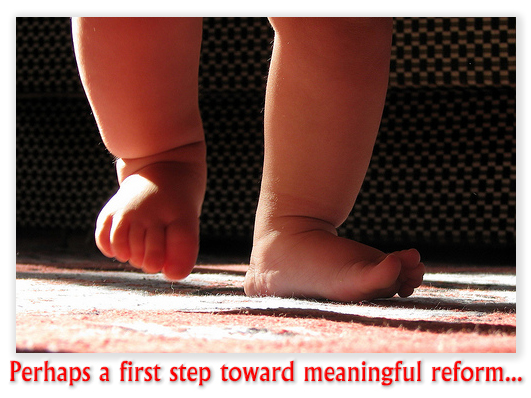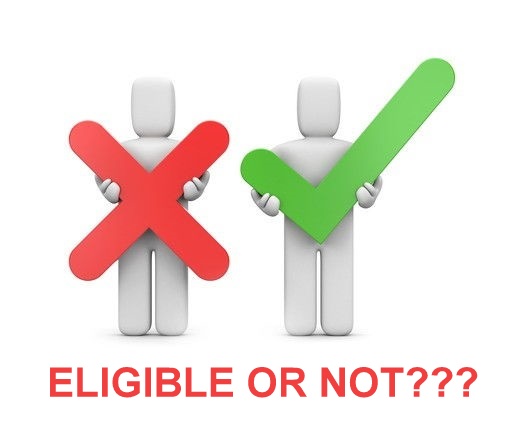We post news and comment on federal criminal justice issues, focused primarily on trial and post-conviction matters, legislative initiatives, and sentencing issues.
FULL HOUSE OF REPRESENTATIVES PASSES FIRST STEP ACT, PUTS THE BALL IN THE SENATE’S COURT
 The U.S. House of Representatives upped the ante on criminal justice reform late yesterday afternoon by passing the admittedly limited (and some say flawed) FIRST STEP Act, H.R. 5682, by an overwhelming 350-59 vote.
The U.S. House of Representatives upped the ante on criminal justice reform late yesterday afternoon by passing the admittedly limited (and some say flawed) FIRST STEP Act, H.R. 5682, by an overwhelming 350-59 vote.
The bill, called the “Formerly Incarcerated Reenter Society Transformed Safely Transitioning Every Person Act’’ or the ‘‘FIRST STEP Act,” offers more funding for prison programs in an attempt to reduce inmates’ likelihood to re-offend after they’ve been released.
The House Judiciary Committee approved the bill two weeks ago by a 25-5 vote, sending it to the House floor for a vote, replacing the Prison Reform and Redemption Act, H.R. 3356. Reps. Doug Collins (R-Georgia) and Hakeem Jeffries (D-New York), co-sponsors of the PRRA, wheeled and dealt with committee members to revise a number of provisions, which resulted in their introducing the new FIRST STEP Act.

There is a lot that must happen before the legislation becomes law, and there is no guarantee that the Senate will even bring it to a vote, let alone pass it. Sen. Charles Grassley (R-Iowa) is already drawing a red line, demanding that sentencing reform be included.
But if the measure did become law as it is written today, this is some of what it would do:
(1) RISK ASSESSMENT AND PROGRAMMING CREDIT
FIRST STEP proposes to use a new “risk assessment” tool, which the Federal Bureau of Prisons will develop and employ over 18 months to calculate how likely an inmate is to commit new crimes upon release. Once everyone is assessed as minimum, low, medium or high, some inmates will be entitled to get earned-time credits that may be cashed in for more halfway house or home confinement that what BOP was otherwise prepared to offer.
 The BOP is responsible for identifying the programs that will entitle inmates to credit. Programs that could earn credit include working at UNICOR, RDAP, GED and adult education programs, as well as mental health programs. Inmates participating the approved programs can earn 10 days of credit for every 30 days of classes. Once an inmate has worked down to the minimum risk for recidivism, he or she can get 15 days for every 30 days of programming. The bill also provides that while inmates are successfully completing courses, the BOP should extend other benefits, including higher commissary spending limits, longer phone time, more visiting hours, and closer-to-home transfers. The bill suggests that all inmates can earn these rewards, but only eligible inmates can get time credits.
The BOP is responsible for identifying the programs that will entitle inmates to credit. Programs that could earn credit include working at UNICOR, RDAP, GED and adult education programs, as well as mental health programs. Inmates participating the approved programs can earn 10 days of credit for every 30 days of classes. Once an inmate has worked down to the minimum risk for recidivism, he or she can get 15 days for every 30 days of programming. The bill also provides that while inmates are successfully completing courses, the BOP should extend other benefits, including higher commissary spending limits, longer phone time, more visiting hours, and closer-to-home transfers. The bill suggests that all inmates can earn these rewards, but only eligible inmates can get time credits.
Priority for participation in recidivism reduction programs is to be given to medium-risk and high-risk prisoners, with access to productive activities given to minimum-risk and low-risk prisoners. Inmates may use credits earned in the programs to serve more time in halfway houses or on home confinement.
(2) GOOD TIME INCREASE
Title 18, USC 3624(b) has always said that inmates can earn 54 days a year in good time. The BOP, however, interpreted the statute to mean that after a year, you get your 54 days. Everyone else thought that you get 54 days after 319 days, to make a full year. The difference in interpretation, upheld by the Supreme Court, was seven days.
 FIRST STEP cleans up the good-time language of 18 USC 3624(b) to give inmates the extra seven days, and makes the change retroactive to the first day of all current sentences. So in a 60-month sentence, an inmate would get 35 more days lopped off his sentence. It may not seem like a lot, but everyone with an “out date” – no matter what the offense – gets the cut. This is estimated to affect 93% of all federal inmates (the remainder serving life sentences or on death row).
FIRST STEP cleans up the good-time language of 18 USC 3624(b) to give inmates the extra seven days, and makes the change retroactive to the first day of all current sentences. So in a 60-month sentence, an inmate would get 35 more days lopped off his sentence. It may not seem like a lot, but everyone with an “out date” – no matter what the offense – gets the cut. This is estimated to affect 93% of all federal inmates (the remainder serving life sentences or on death row).
(3) CLOSER TO HOME
The bill also directs the BOP to make placing an inmate near home for his or her whole bit a top priority. BOP still has wiggle room for bed space, programming, CIM status and the such, but the 500-mile distance will now be 500 driving miles, not the 500 straight-line miles BOP used previously, which were a hardship to so many. And it will make the 500-mile limit a statutory imperative, harder for the BOP to ignore.
(4) MAX HOME CONFINEMENT
The bill also amends 18 USC Sec. 3624(c)(2) to require the BOP, “to the extent practicable, place prisoners with lower risk levels and lower needs on home confinement for the maximum amount of time permitted under this paragraph.” That time, 10% of a sentence up to a maximum of six months, remains unchanged.
(5) ELDERLY OFFENDER, COMPASSIONATE RELEASE WILL BE D-I-Y
 The bill changes the elderly offender program, extending it to the whole BOP system, not just a few prisons. It also drops the age for elderly offenders from 65 to 60, drops the requirement that the amount of the sentence served from 75% to 67%, and completely eliminates the requirement that the inmate serve a minimum of 10 years.
The bill changes the elderly offender program, extending it to the whole BOP system, not just a few prisons. It also drops the age for elderly offenders from 65 to 60, drops the requirement that the amount of the sentence served from 75% to 67%, and completely eliminates the requirement that the inmate serve a minimum of 10 years.
Best of all, the elderly offender program, the eligible terminally ill offender program, and the compassionate release programs would all now permit the inmate himself or herself to file with the courts for relief if the BOP fails or refuses to make the request itself.
(6) SO WHO IS ELIGIBLE?
Everyone other than those with life sentences will get an additional seven days off per year, retroactive to the beginning of their current sentence. Likewise, everyone will be eligible for in-prison benefits like higher commissary limits, better visitation, preferential housing, or more phone time.
 However, the real prize for completion of rehab programs will be the RRC credits, additional time awarded to people for halfway house or home confinement, and there is a long list of inmates not eligible for RRC credits. The most common excluded categories are people serving sentences under Title 18 or Title 21 for
However, the real prize for completion of rehab programs will be the RRC credits, additional time awarded to people for halfway house or home confinement, and there is a long list of inmates not eligible for RRC credits. The most common excluded categories are people serving sentences under Title 18 or Title 21 for
(1) Sec. 113(a)(1), relating to assault with intent to commit murder.
(2) Sec. 115, relating to influencing, impeding, or retaliating against an official by injuring a family member, except for a threat made in violation of that section
(3) Any section of chapter 10, relating to biological weapons.
(4) Any section of chapter 115, relating to chemical weapons.
(5) Any Sec. of chapter 39, relating to explosives and other dangerous articles, except for Sec. 836 (relating to the transportation of fireworks into a State prohibiting sale or use).
(6) Sec. 842(p), relating to distribution of information relating to explosive, destructive devices, and weapons of mass destruction, but only if the conviction involved a weapon of mass destruction (as defined in Sec. 23382a(c)(2) of such title).
(7) Subsec. (f)(38), (h), or (1) of Sec. 844, relating to the use of fire or an explosive.
(8) Sec. 924(e), relating to unlawful possession of a firearm by a person with 3 or more convictions for a violent, felony.
(9) Sec. 10380(a)(1), relating to fraud and related activity in connection with computers.
(10) Any section of chapter 951, relating to homicide, except for Sec. 1112 (relating to manslaughter), 1113 (relating to attempt to commit murder or manslaughter, but only 1f the conviction was for an attempt to commit manslaughter), 1115 (relating to misconduct or neglect of ship officers), or 1122 (relating to protection against the human immunodeficiency virus).
(11) Any section of chapter 55, relating to kidnapping.
(12) Any offense under chapter 77, relating to peonage, slavery, and trafficking in persons, except for Secs 1592 through 1596.
(13) Sec. 1751, relating to Presidential and Presidential staff assassination, kidnapping, and assault.
(14) Sec. 1841(a)(2)(C), relating to intentionally killing or attempting to kill an unborn child.
(15) Sec. 1992, relating to terrorist attacks and other violence against railroad carriers and against mass transportation systems on land, on water, or through the air.
(16) Sec. 2113(e), relating to bank robbery resulting in death.
(17) Sec. 2118(e)(2), relating’ to robberies and burglaries involving controlled substances resulting in death.
(18) Sec. 2119(3), relating to taking a motor vehicle (commonly referred to as ‘carjacking’) that results in death.
(19) Any section of chapter 109A, relating to sexual abuse, except that with regard to Sec. 2244, only a conviction under subsec. (c) of that section (relating to abusive sexual contact involving young children) shall make a prisoner ineligible under this subparagraph.
(20) Sec. 2251, relating to the sexual exploitation of children.
(21) Sec. 22514, relating to the selling or buying of children.
(22) Any of paragraphs (1) through (3) of Sec. 2252(a), relating to certain activities relating to material involving the sexual exploitation of minors.
(23) A second or subsequent conviction under any of paragraphs (1) through (6) of Sec. 2252A(a), relating to certain activities relating to material constituting or containing child pornography.
(24) Sec. 2260, relating to the production of sexually explicit depictions of a minor for importation into the United States.
(25) Sec. 2284, relating to the transportation of terrorists.
(26) Sec. 2291, relating to the destruction of a vessel or maritime facility, but only 1f the conduct which led to the conviction involved a substantial risk of death or serious bodily injury.
(27) Any section of chapter 1135, relating to terrorism.
(28) Sec. 2340A, relating to torture
(29) Sec. 2381, relating to treason
(30) Sec. 2442, relating to the recruitment or use of child soldiers.
 (31) Sec. 401(a) of the Controlled Substances Act (21 U.S.C. 841) relating to manufacturing or distributing a controlled substance, but only in the case of a conviction for an offense described in subparagraph (A), (B), or (C) of subsec. (b)(1) of that section for which death or serious bodily injury resulted from the use of such substance.
(31) Sec. 401(a) of the Controlled Substances Act (21 U.S.C. 841) relating to manufacturing or distributing a controlled substance, but only in the case of a conviction for an offense described in subparagraph (A), (B), or (C) of subsec. (b)(1) of that section for which death or serious bodily injury resulted from the use of such substance.
(32) Sec. 276(a) of the Immigration and Nationality Act (8 U.S.C. 1326), relating to the reentry of a removed alien, but only if the alien is described in paragraph (1) or (2) of subsec. (b) of that section.
(33) Sec. 601 of the National Security Act of 1947 (50 U.S.C. 3121), relating to the protection of identities of certain United States undercover intelligence officers, agents, informants, and sources.
(34) An offense described in Sec. 3559(c)(2)(F), for which the offender was sentenced to a term of imprisonment of more than one year, if the offender has a previous conviction for which the offender served a term of Imprisonment of more than one year, for a Federal or State offense, by whatever designation and wherever committed, consisting of murder (as described in Sec. 1111), voluntary manslaughter (as described in Sec. 1112), assault with intent to commit murder (as described in Sec. 113(a)), aggravated sexual abuse and sexual abuse (as described in Secs 2241 and 2242), abusive sexual contact (as described in Secs 2244(a)(1) and (a)(2)), kidnapping (as described in chapter 55), carjacking (as described in Sec. 2119), arson (as described in Sec. 844(f)(3), (h), or ()), or terrorism (as described in chapter 113B).
H.R. 5682, Formerly Incarcerated Reenter Society Transformed Safely Transitioning Every Person Act (passed by the House of Representatives May 22, 2018)
– Thomas L. Root

